Preparation of Waste PP/Fly Ash/Waste Stone Powder Composites and Evaluation of Their Mechanical Properties
Abstract
1. Introduction
2. Materials and Methods
2.1. Preparation of Composite Plastic Pellets
2.2. Injection Molding Experimental Details
2.3. Characterization Analysis Method
2.4. Thermogravimetric Analysis
2.5. Mechanical Properties Analysis Method
3. Results and Discussion
3.1. Characterization Analysis
3.1.1. SEM and EDS Analysis
3.1.2. XRD and FT-IR Analysis
3.2. Mass Variation Characteristics
3.3. Thermogravimetric Analysis
3.4. Mechanical Properties
3.4.1. Tensile Strength
3.4.2. Bending Strength
3.4.3. Notched Impact Energy
4. Conclusions
- i.
- A series of PP/FA/WSP composites were successfully prepared through the injection molding machine, even if the total mixing ratio of FA and WSP is as high as 50 wt%.
- ii.
- SEM, EDS, XRD and FTIR analysis results show that the distribution of FA and WSP in PP is uniform. There are no cracks, fractures or other defects on the surface of PP/FA/WSP composites.
- iii.
- TGA results show that the weight ratio of all PP/FA/WSP composites is similar to the predetermined value. It indicates that FA, WSP and PP are uniformly mixed and the injection molding method is suitable for preparing PP/FA/WSP composite materials.
- iv.
- For mechanical properties, although the addition of FA and WSP leads to a decrease in the tensile strength of PP/FA/WSP composites, the addition of appropriate amounts of FA and WSP leads to an increase in the bending strength and notched impact energy of PP/FA/WSP composites by 2.20–4.71% and 14.58–22.22%, respectively.
Author Contributions
Funding
Institutional Review Board Statement
Informed Consent Statement
Data Availability Statement
Conflicts of Interest
References
- Milios, L.; Holm Christensen, L.; McKinnon, D.; Christensen, C.; Rasch, M.K.; Hallstrøm Eriksen, M. Plastic recycling in the Nordics: A value chain market analysis. Waste Manag. 2018, 76, 180–189. [Google Scholar] [CrossRef] [PubMed]
- Schmaltz, E.; Melvin, E.C.; Diana, Z.; Gunady, E.F.; Rittschof, D.; Somarelli, J.A.; Virdin, J.; Dunphy-Daly, M.M. Plastic pollution solutions: Emerging technologies to prevent and collectmarineplastic pollution. Environ. Int. 2020, 144, 106067. [Google Scholar] [CrossRef]
- Hopewell, J.; Dvorak, R.; Kosior, E. Plastics recycling: Challenges and opportunities. Philos. Trans. R. Soc. B Biol. Sci. 2009, 364, 2115–2126. [Google Scholar] [CrossRef] [PubMed]
- MacLeod, M.; Arp, H.P.H.; Tekman, M.B.; Jahnke, A. The global threat from plastic pollution. Science 2021, 373, 61–65. [Google Scholar] [CrossRef]
- Peng, Y.; Wu, P.; Schartup, A.T.; Zhang, Y. Plastic waste release caused by COVID-19 and its fate in the global ocean. Proc. Natl. Acad. Sci. USA 2021, 118, e2111530118. [Google Scholar] [CrossRef] [PubMed]
- Williams, A.T.; Rangel-Buitrago, N. The past, present, and future of plastic pollution. Mar. Pollut. Bull. 2022, 176, 113429. [Google Scholar] [CrossRef]
- Leslie, H.A.; van Velzen, M.J.; Brandsma, S.H.; Vethaak, A.D.; Garcia-Vallejo, J.J.; Lamoree, M.H. Discovery and quantification of plastic particle pollution in human blood. Environ. Int. 2022, 163, 107199. [Google Scholar] [CrossRef]
- Xu, Q.; Xiang, J.; Ko, J.H. Municipal plastic recycling at two areas in China and heavy metal leachability of plastic in municipal solid waste. Environ. Pollut. 2020, 260, 114074. [Google Scholar] [CrossRef] [PubMed]
- Chandara, H.C. Plastic Recyling In Indonesia By Converting Plastic Wastes (Pet, Hdpe, Ldpe, And Pp) Into Plastic Pellets. Asean J. Syst. Eng. 2016, 3, 65–72. [Google Scholar] [CrossRef]
- Naderi Kalali, E.; Lotfian, S.; Entezar Shabestari, M.; Khayatzadeh, S.; Zhao, C.; Yazdani Nezhad, H. A critical review of the current progress of plastic waste recycling technology in structural materials. Curr. Opin. Green Sustain. Chem. 2023, 40, 100763. [Google Scholar] [CrossRef]
- Jahirul, M.I.; Rasul, M.G.; Schaller, D.; Khan, M.M.K.; Hasan, M.M.; Hazrat, M.A. Transport fuel from waste plastics pyrolysis—A review on technologies, challenges and opportunities. Energy Convers. Manag. 2022, 258, 115451. [Google Scholar] [CrossRef]
- Jiang, J.; Shi, K.; Zhang, X.; Yu, K.; Zhang, H.; He, J.; Ju, Y.; Liu, J. From plastic waste to wealth using chemical recycling: A review. J. Environ. Chem. Eng. 2021, 10, 106867. [Google Scholar] [CrossRef]
- Delacuvellerie, A.; Ballerini, T.; Frère, L.; Matallana-Surget, S.; Dumontet, B.; Wattiez, R. From rivers to marine environments: A constantly evolving microbial community within the plastisphere. Mar. Pollut. Bull. 2022, 179, 113660. [Google Scholar] [CrossRef] [PubMed]
- Sirin, M.; Zeybek, M.S.; Sirin, K.; Abali, Y. Effect of gamma irradiation on the thermal and mechanical behaviour of polypropylene and polyethylene blends. Radiat. Phys. Chem. 2022, 194, 110034. [Google Scholar] [CrossRef]
- Maddah, H.A. Polypropylene as a promising plastic: A review. Am. J. Polym. Sci. 2016, 6, 1–11. [Google Scholar]
- Kotova, O.B.; Shushkov, D.A.; Kotova, E.L.; Simakova, Y.S.; Popova, E.V. Zeolite synthesis as potential application of coal fly ash. In XVIII International Coal Preparation Congress; Springer: Berlin/Heidelberg, Germany, 2016; pp. 321–326. [Google Scholar]
- Naganathan, S.; Mohamed, A.Y.O.; Mustapha, K.N. Performance of bricks made using fly ash and bottom ash. Constr. Build. Mater. 2015, 96, 576–580. [Google Scholar] [CrossRef]
- Wang, P.; Wang, J.; Qin, Q.; Wang, H. Life cycle assessment of magnetized fly-ash compound fertilizer production: A case study in China. Renew. Sustain. Energy Rev. 2017, 73, 706–713. [Google Scholar] [CrossRef]
- Ahmaruzzaman, M. A review on the utilization of fly ash. Prog. Energy Combust. Sci. 2010, 36, 327–363. [Google Scholar] [CrossRef]
- Lim, W.-R.; Park, J.-H.; Lee, C.-H. Characterizing crystalline phase transitions in zeolitization of coal fly ash using focused ion beam-scanning electron microscopy. Surf. Interfaces 2023, 36, 102536. [Google Scholar] [CrossRef]
- Karabul, Y.; Kılıç, M.; Güven Özdemir, Z. Geochemical and energy storage properties of natural stones belong to limestone and Fe-shale families. Phys. Chem. Earth Parts A/B/C 2022, 128, 103283. [Google Scholar] [CrossRef]
- Hu, J.; Ren, Q.; Jiang, Q.; Gao, R.; Zhang, L.; Luo, Z. Strength characteristics and the reaction mechanism of stone powder cement tailings backfill. Adv. Mater. Sci. Eng. 2018, 2018, 1–14. [Google Scholar] [CrossRef]
- Jung, S.-H.; Saraswathy, V.; Karthick, S.; Kathirvel, P.; Kwon, S.-J. Microstructure characteristics of fly ash concrete with rice husk ash and lime stone powder. Int. J. Concr. Struct. Mater. 2018, 12, 17. [Google Scholar] [CrossRef]
- Fages, E.; Pascual, J.; Fenollar, O.; García-Sanoguera, D.; Balart, R. Study of antibacterial properties of polypropylene filled with surfactant-coated silver nanoparticles. Polym. Eng. Sci. 2011, 51, 804–811. [Google Scholar] [CrossRef]
- Wang, S.; Ajji, A.; Guo, S.; Xiong, C. Preparation of microporous polypropylene/titanium dioxide composite membranes with enhanced electrolyte uptake capability via melt extruding and stretching. Polymers 2017, 9, 110. [Google Scholar] [CrossRef]
- Shen, Y.; Qian, J.; Zhang, Z. Investigations of anhydrite in CFBC fly ash as cement retarders. Constr. Build. Mater. 2012, 40, 672–678. [Google Scholar] [CrossRef]
- Sahu, R.; Gupta, M.K.; Chaturvedi, R.; Tripaliya, S.S.; Pappu, A. Moisture resistant stones waste based polymer composites with enhanced dielectric constant and flexural strength. Compos. Part B Eng. 2019, 182, 107656. [Google Scholar] [CrossRef]
- Prabowo, I.; Pratama, J.N.; Chalid, M. The effect of modified ijuk fibers to crystallinity of polypropylene composite. IOP Conf. Ser. Mater. Sci. Eng. 2017, 223, 012020. [Google Scholar] [CrossRef]
- Kalembkiewicz, J.; Galas, D.; Sitarz-Palczak, E. The Physicochemical Properties and Composition of Biomass Ash and Evaluating Directions of its Applications. Pol. J. Environ. Stud. 2018, 27, 2593–2603. [Google Scholar] [CrossRef]
- Nath, S.; Kumar, S. Role of particle fineness on engineering properties and microstructure of fly ash derived geopolymer. Constr. Build. Mater. 2019, 233, 117294. [Google Scholar] [CrossRef]
- Panias, D.; Giannopoulou, I.P.; Perraki, T. Effect of synthesis parameters on the mechanical properties of fly ash-based geopolymers. Colloids Surf. Physicochem. Eng. Asp. 2007, 301, 246–254. [Google Scholar] [CrossRef]
- Ge, X.; Hu, X.; Shi, C. The effect of different types of class F fly ashes on the mechanical properties of geopolymers cured at ambient environment. Cem. Concr. Compos. 2022, 130, 104528. [Google Scholar] [CrossRef]
- Paramasivan, S.; Rajagopal, T. Experimental study on geopolymer concrete with partial replacement of bethamcherla waste stone powder. Glob. NEST J. 2023, 25, 1–5. [Google Scholar]
- Rajendrana, D.; Christopher, C.G.; Muthuc, M.S. Self-compacting concrete made with partial replacement of lime stone and quarry dust powder. Res. Eng. Struct. Mater. 2022, 8, 633–642. [Google Scholar] [CrossRef]
- Alwesabi, E.A.; Abu Bakar, B.; Alshaikh, I.M.; Zeyad, A.M.; Altheeb, A.; Alghamdi, H. Experimental investigation on fracture characteristics of plain and rubberized concrete containing hybrid steel-polypropylene fiber. Structures 2021, 33, 4421–4432. [Google Scholar] [CrossRef]
- Park, S.S.; Seo, D.K.; Lee, S.H.; Yu, T.-U.; Hwang, J. Study on pyrolysis characteristics of refuse plastic fuel using lab-scale tube furnace and thermogravimetric analysis reactor. J. Anal. Appl. Pyrolysis 2012, 97, 29–38. [Google Scholar] [CrossRef]
- Eriksen, M.; Christiansen, J.; Daugaard, A.; Astrup, T. Closing the loop for PET, PE and PP waste from households: Influence of material properties and product design for plastic recycling. Waste Manag. 2019, 96, 75–85. [Google Scholar] [CrossRef]
- Ul Haq, E.; Kunjalukkal Padmanabhan, S.; Licciulli, A. Synthesis and characteristics of fly ash and bottom ash based geopolymers–A comparative study. Ceram. Int. 2014, 40, 2965–2971. [Google Scholar] [CrossRef]
- Yang, H.-S.; Kim, H.-J.; Son, J.; Park, H.-J.; Lee, B.-J.; Hwang, T.-S. Rice-husk flour filled polypropylene composites; mechanical and morphological study. Compos. Struct. 2004, 63, 305–312. [Google Scholar] [CrossRef]
- Pardo, S.; Bernal, C.; Ares, A.; Abad, M.; Cano, J. Rheological, thermal, and mechanical characterization of fly ash-thermoplastic composites with different coupling agents. Polym. Compos. 2010, 31, 1722–1730. [Google Scholar] [CrossRef]
- Sengupta, S.; Pal, K.; Ray, D.; Mukhopadhyay, A. Furfuryl palmitate coated fly ash used as filler in recycled polypropylene matrix composites. Compos. Part B Eng. 2011, 42, 1834–1839. [Google Scholar] [CrossRef]
- Li, W.-P.; Huang, H.-X. Revealing toughening mechanism for alternating multilayered polypropylene/poly(ethylene-co-octene) sheets. Polym. Test. 2015, 41, 245–251. [Google Scholar] [CrossRef]
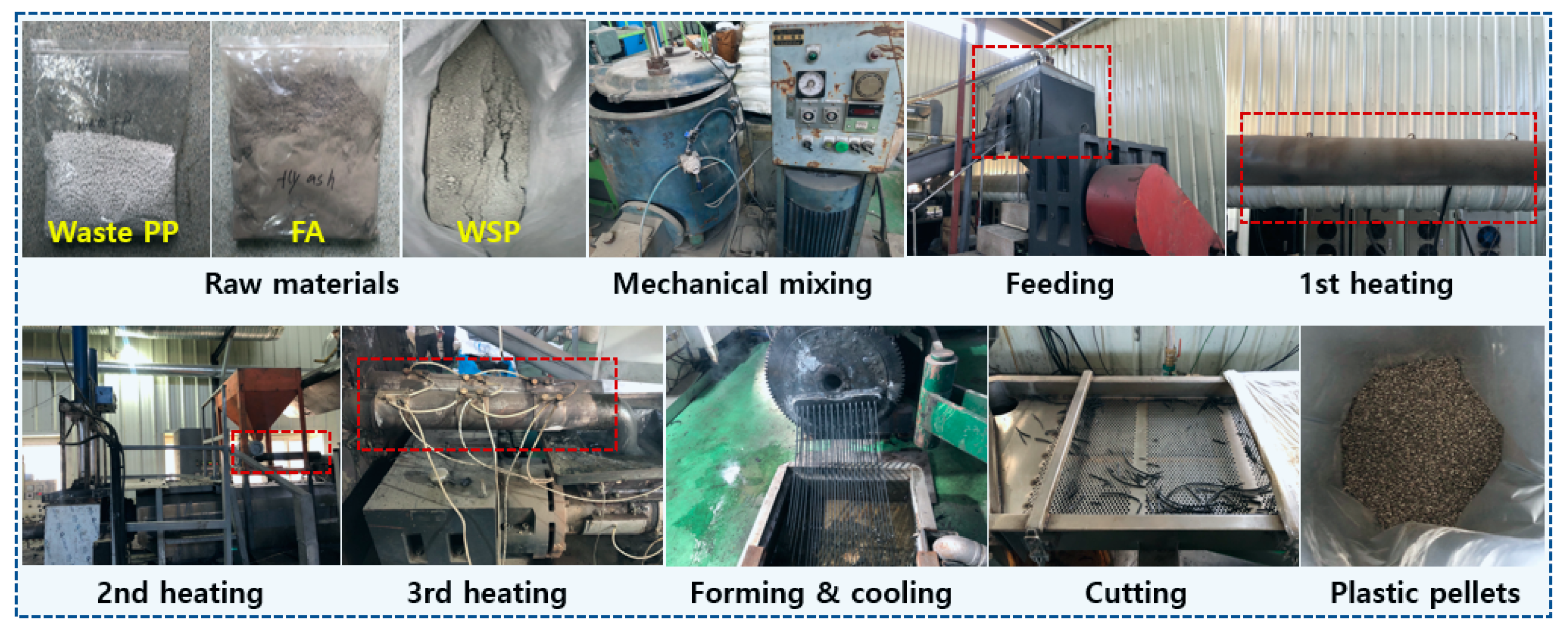


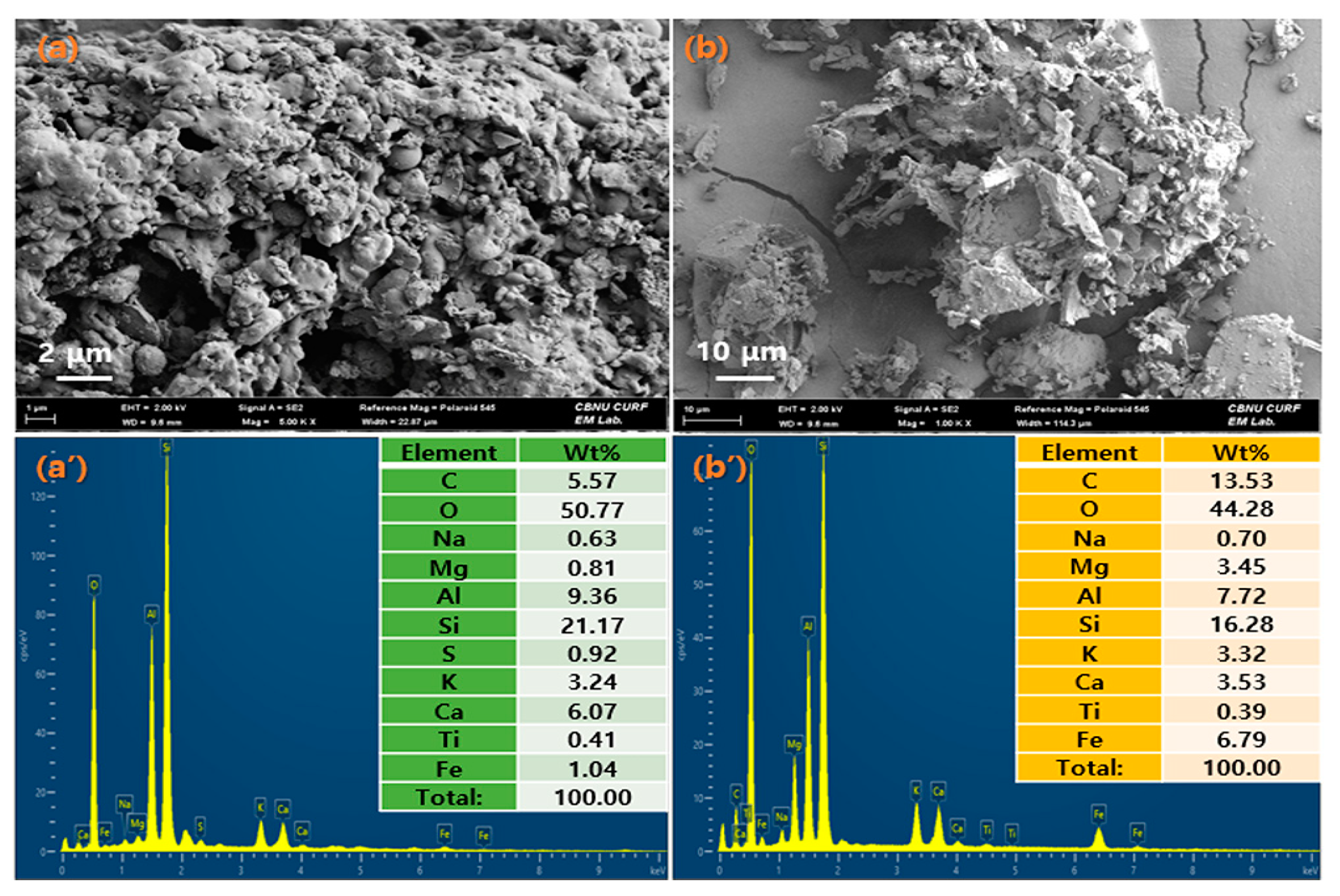
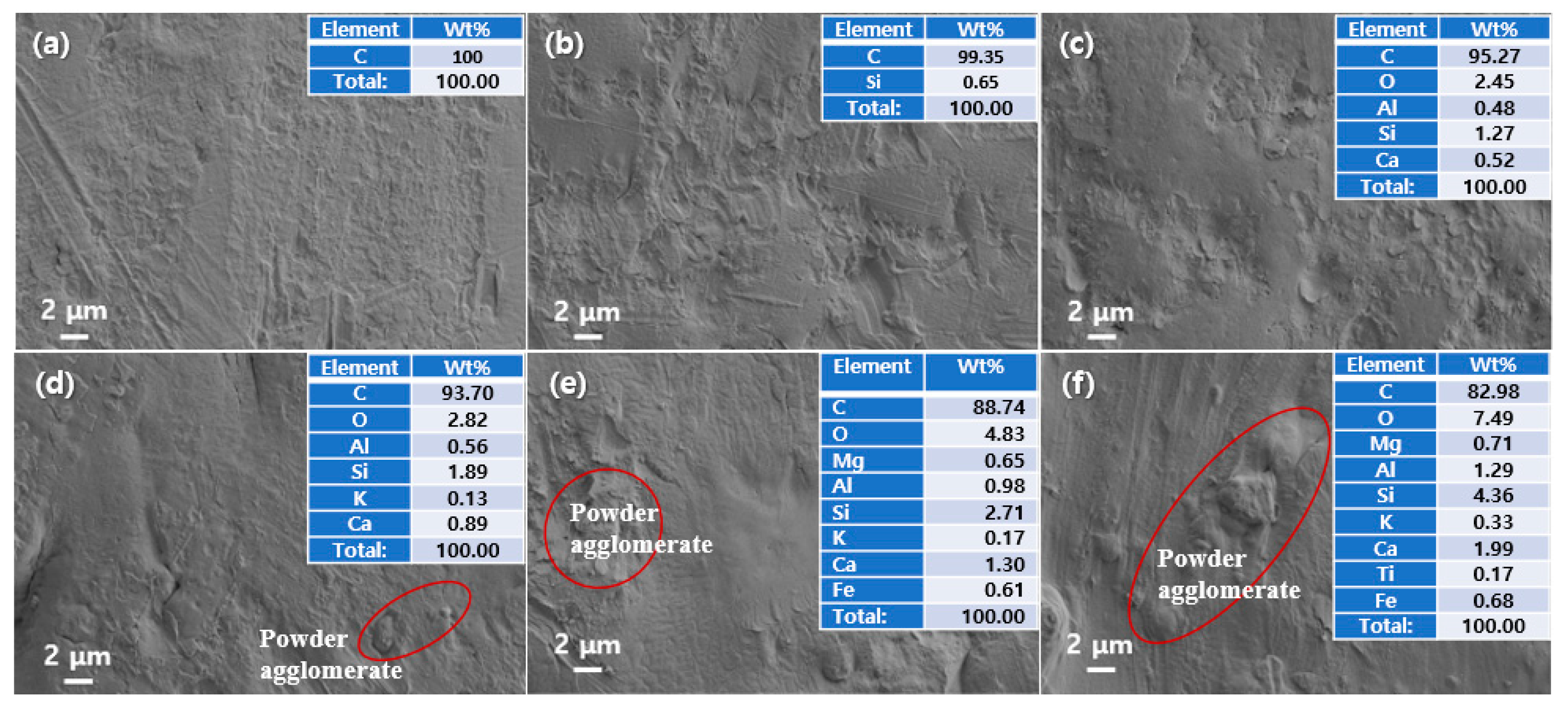
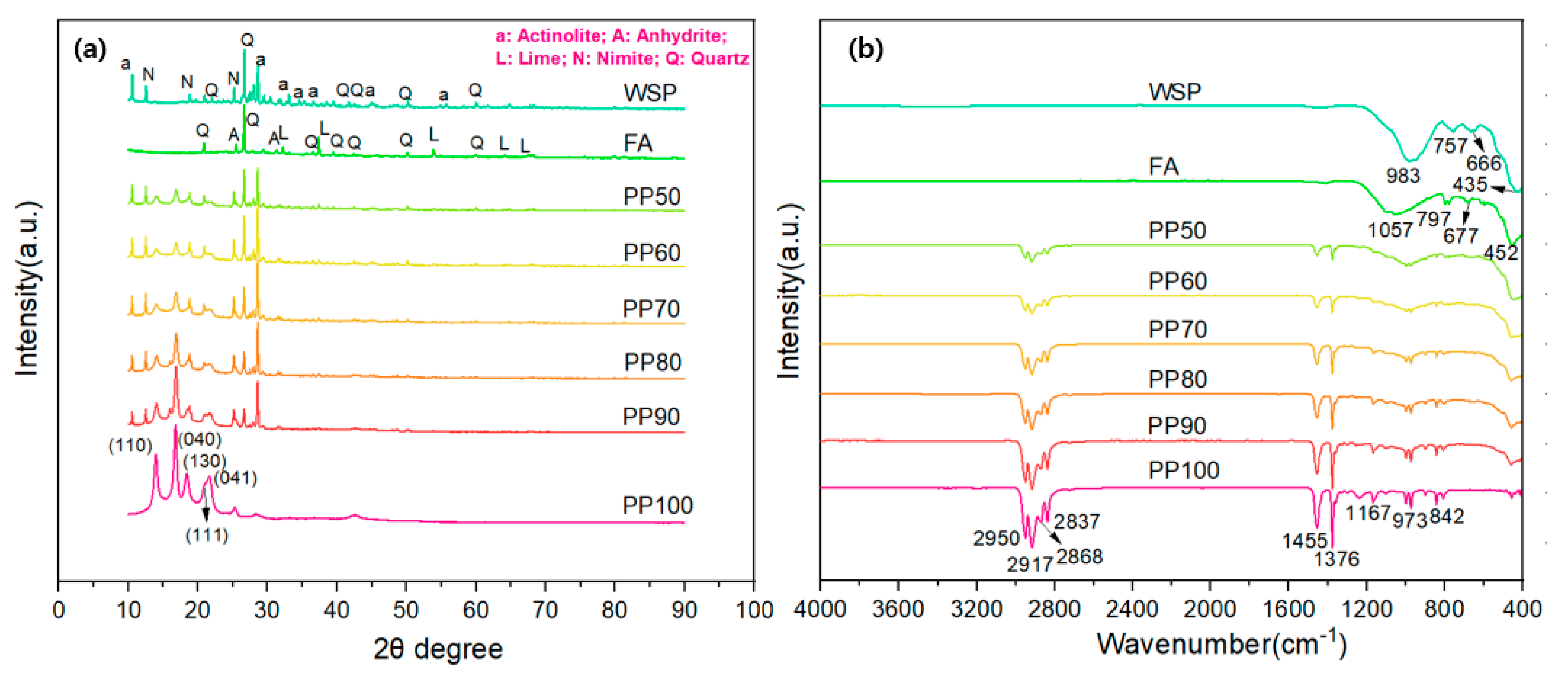
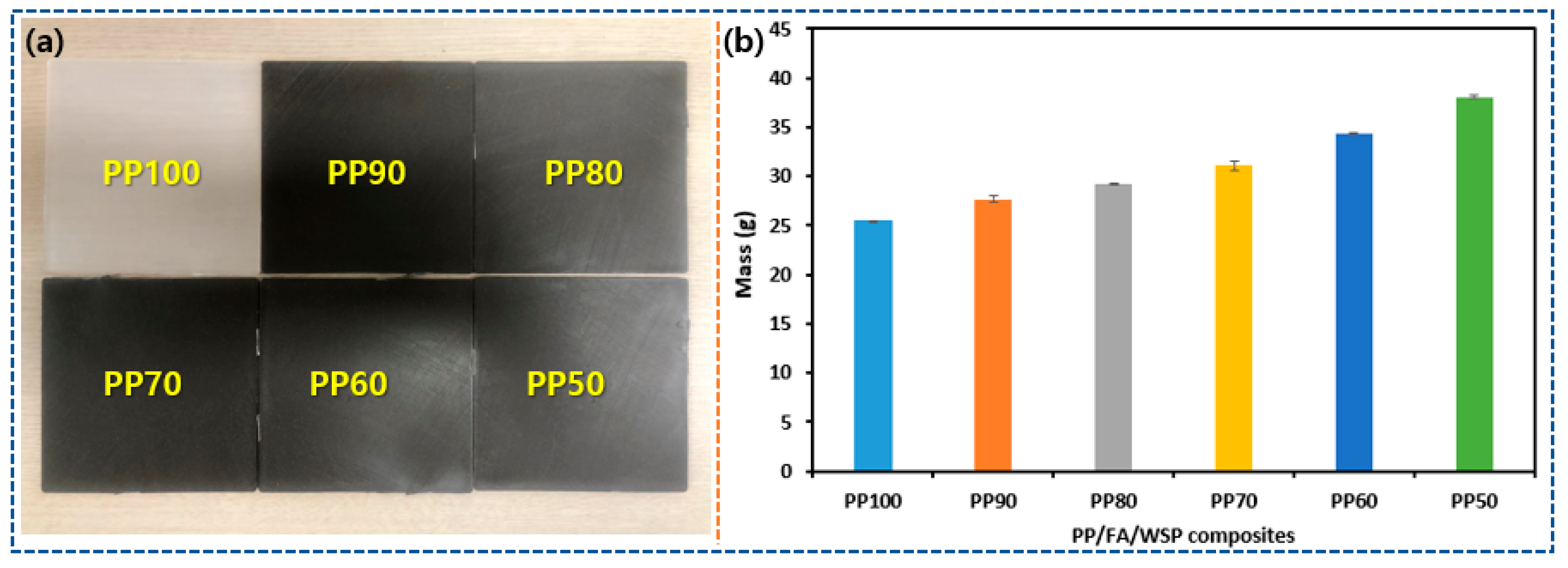
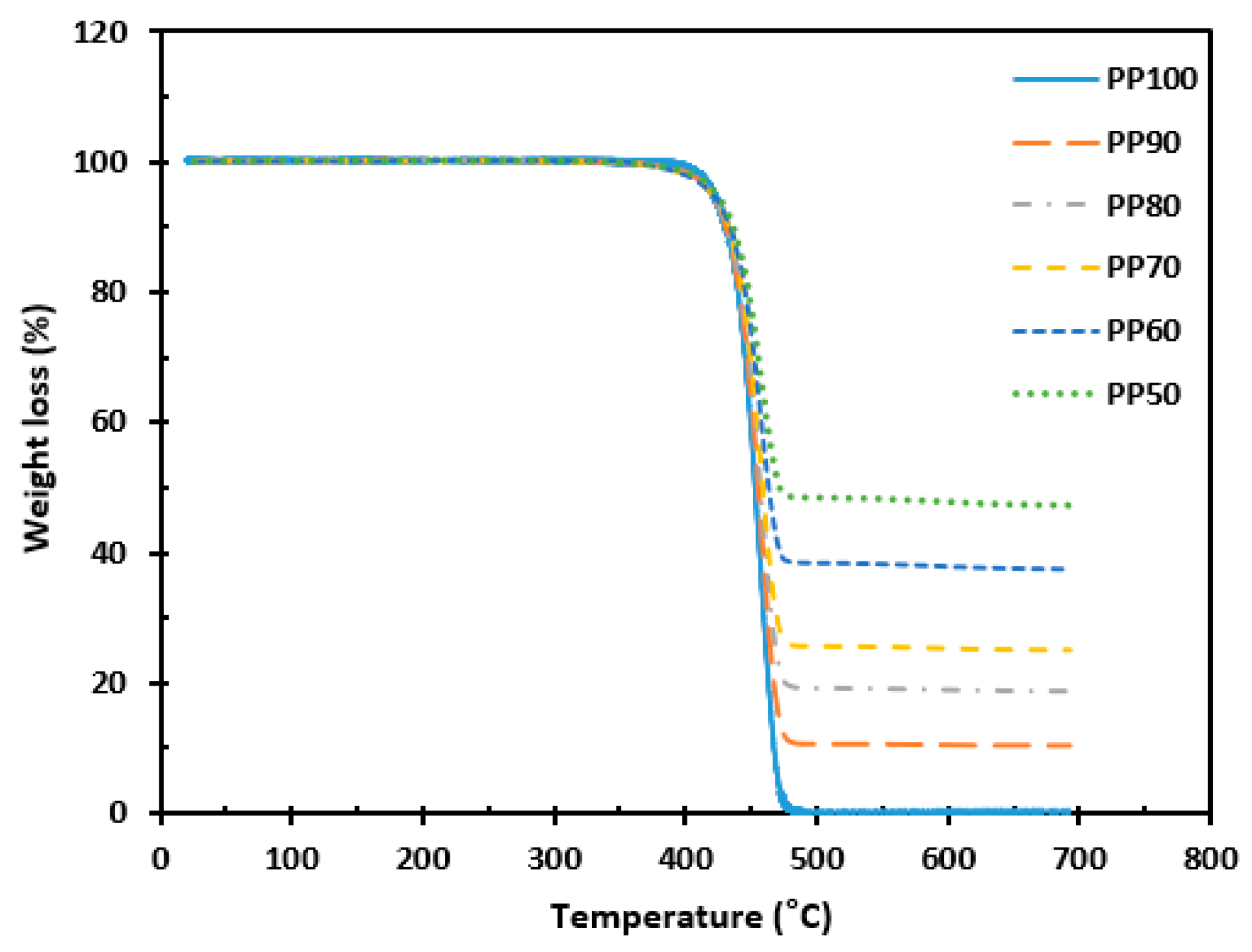

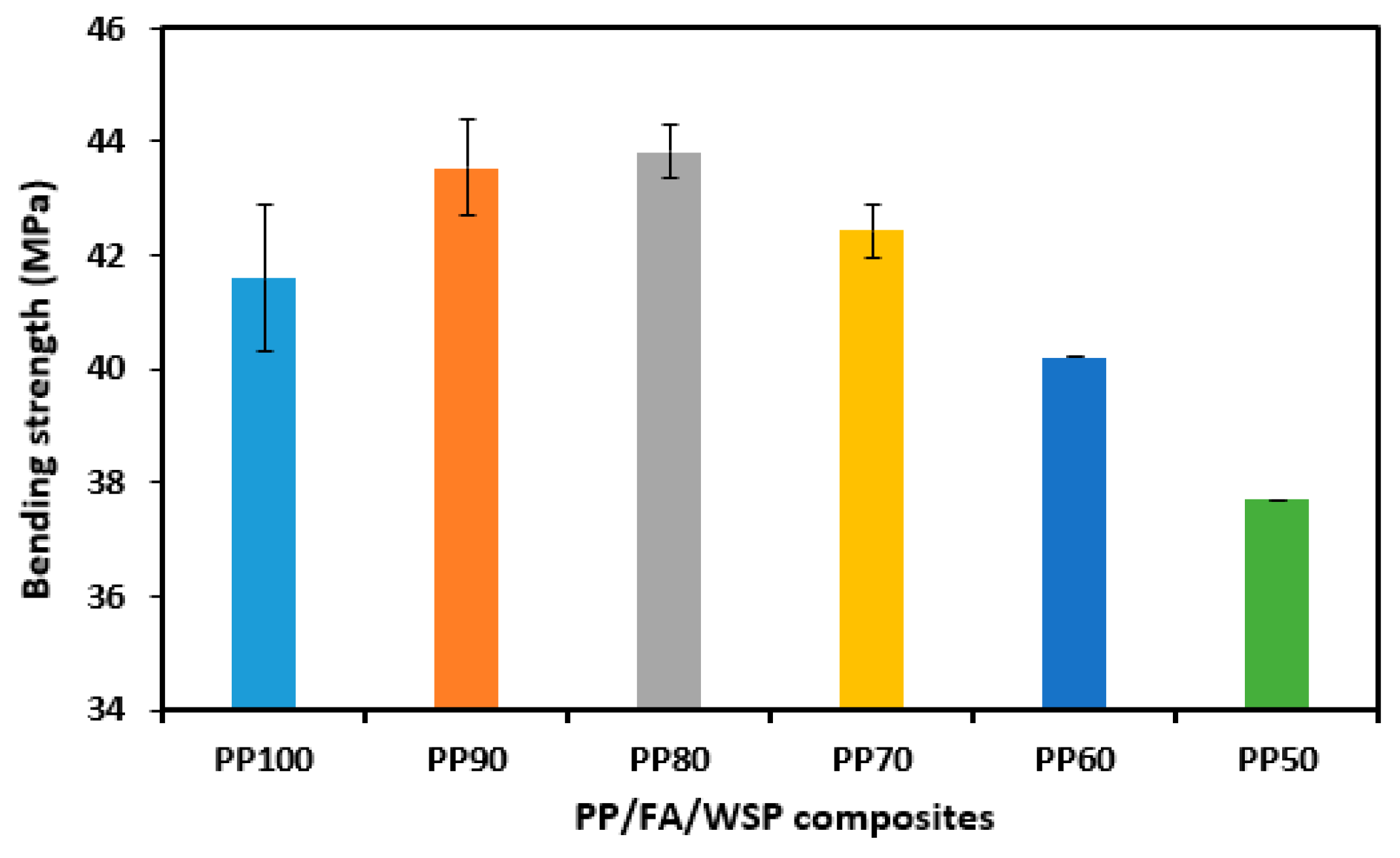
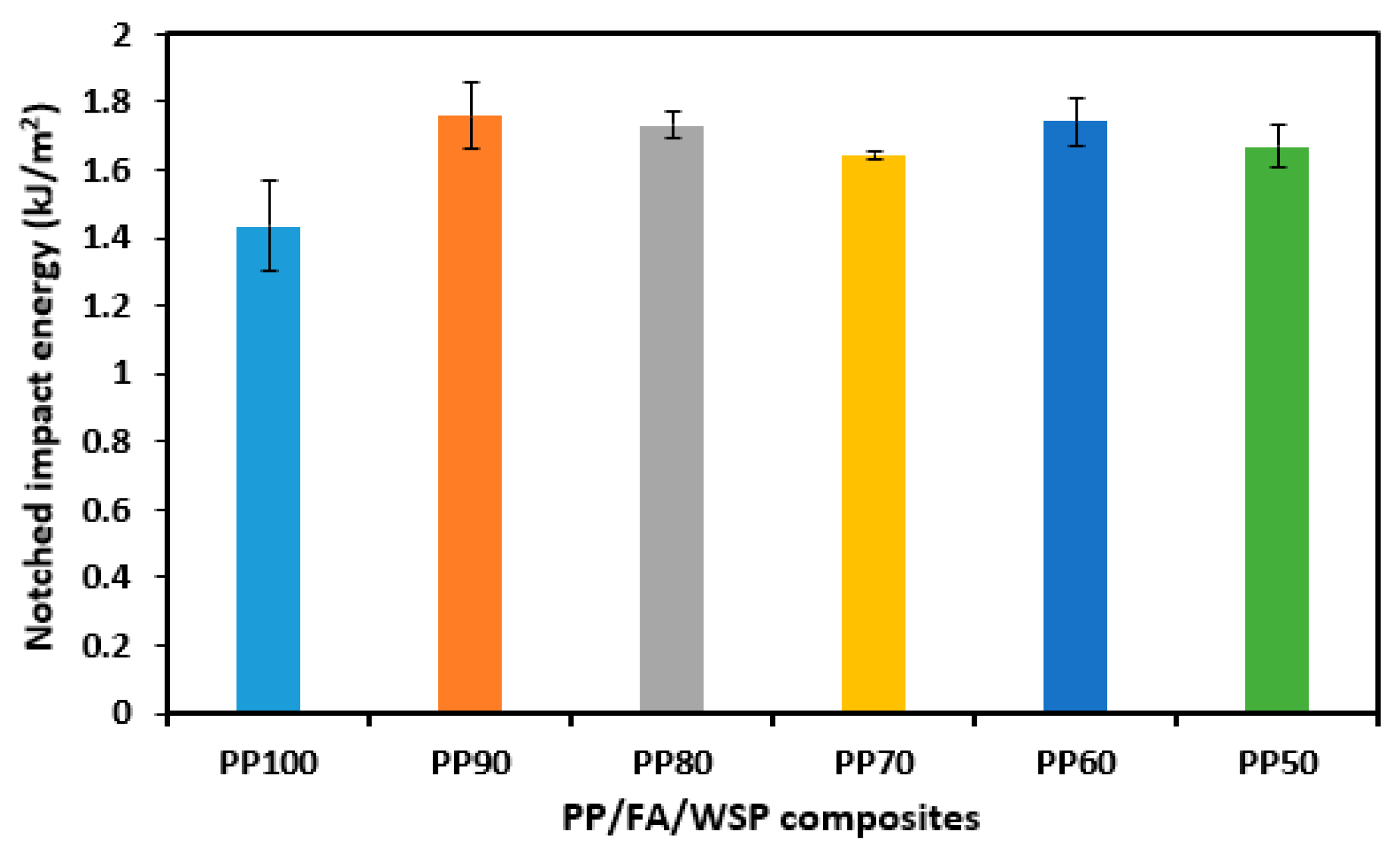
Disclaimer/Publisher’s Note: The statements, opinions and data contained in all publications are solely those of the individual author(s) and contributor(s) and not of MDPI and/or the editor(s). MDPI and/or the editor(s) disclaim responsibility for any injury to people or property resulting from any ideas, methods, instructions or products referred to in the content. |
© 2023 by the authors. Licensee MDPI, Basel, Switzerland. This article is an open access article distributed under the terms and conditions of the Creative Commons Attribution (CC BY) license (https://creativecommons.org/licenses/by/4.0/).
Share and Cite
Ge, J.C.; Lee, E.S.; Kim, D.J.; Kang, J.H.; Im, I.T.; Choi, N.J. Preparation of Waste PP/Fly Ash/Waste Stone Powder Composites and Evaluation of Their Mechanical Properties. Materials 2023, 16, 3687. https://doi.org/10.3390/ma16103687
Ge JC, Lee ES, Kim DJ, Kang JH, Im IT, Choi NJ. Preparation of Waste PP/Fly Ash/Waste Stone Powder Composites and Evaluation of Their Mechanical Properties. Materials. 2023; 16(10):3687. https://doi.org/10.3390/ma16103687
Chicago/Turabian StyleGe, Jun Cong, Eun Seo Lee, Deuk Ju Kim, Ji Ho Kang, Ik Tae Im, and Nag Jung Choi. 2023. "Preparation of Waste PP/Fly Ash/Waste Stone Powder Composites and Evaluation of Their Mechanical Properties" Materials 16, no. 10: 3687. https://doi.org/10.3390/ma16103687
APA StyleGe, J. C., Lee, E. S., Kim, D. J., Kang, J. H., Im, I. T., & Choi, N. J. (2023). Preparation of Waste PP/Fly Ash/Waste Stone Powder Composites and Evaluation of Their Mechanical Properties. Materials, 16(10), 3687. https://doi.org/10.3390/ma16103687







